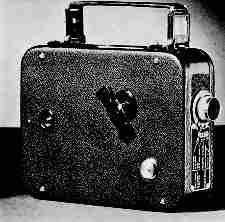Toronto. In the summer of 1932, the great depression was well underway and grabbing the countries of the world in a death grip, eased a few years later by a world-wide war. In the August, 1932 issue of American Cinematographer, Kodak proudly announced a new camera, one that loaded 25 feet of 16mm film, that after processing and slicing by Kodak became 50 feet of 8mm film ready for projection, running as long as 100 feet of 16mm film.
Kodak’s emphasis was on how much the camera would save, implying that, “The quality of the resulting motion pictures is pronounced very high by persons who have seen them projected in Rochester.”
I can remember 8mm later on when 16mm Kodachrome was available for them. Not so sure “quality” describes the projected image … . Nevertheless, my good friend, George Dunbar, himself a cinematographer as well as a still photographer is commended for discovering and sharing this announcement of the new 8mm movie format aimed at an audience of would-be movie makers less concerned with quality than with economy in the dark days of the 1930s.









